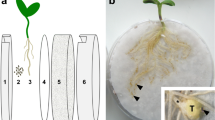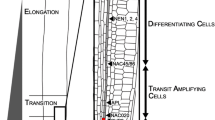Summary
The stem ofPotamogeton natans is characterized by a central stelar vascular system with reduced xylem and abundant phloem. Wide sieve tubes composed of short sieve-tube members joined by simple sieve plates and associated with companion cells establish an effective conduit for assimilates. At each node the phloem forms a network of parallel sieve elements connecting the stem phloem to leaf and bud traces. InP. natans an axillary bud rarely develops into a side branch, its procambial vascular bundles are each connected to the nodal complex via separate anastomoses. Their most unusual components are the anastomosai sieve elements (ANSE), characterized by thin cell walls pitted all over by tiny callose-lined pores resembling plasmodesmata, which can be detected as bright areas by fluorescence microscopy after staining with aniline blue. Several layers of ANSE make up the centre of an anastomosis and link to both the nodal and bud stelar sieve tubes via mediating (MSE) and connecting sieve elements (CSE). The ultrastructural differentiation of ANSE, MSE, and CSE corresponds to that of normal sieve elements, i.e., in the mature stage they are enucleate, evacuolate, and have lost most of their cytoplasm. Their plastids are of form-P2c, containing many cuneate protein crystals, typical of monocotyledonous sieve elements. Quantitative aspects of the “pore” areas are discussed in relation to the functional significance of bud anastomoses.
Similar content being viewed by others
Abbreviations
- ANSE:
-
anastomosai sieve elements
- CSE:
-
connecting sieve elements
- FM:
-
fluorescence microscopy
- LM:
-
light microscopy
- MSE:
-
mediating sieve elements
- TEM:
-
transmission electron microscopy
References
Ayensu ES (1972) Dioscoreales. In: Metcalfe CR (ed) Anatomy of the monocotyledons, vol 6. Clarendon Press, Oxford, pp 1–182
Behnke H-D (1965a) Über das Phloem der Dioscoreaceen unter besonderer Berücksichtigung ihrer Phloembecken: I. Lichtoptische Untersuchungen zur Struktur der Phloembecken und ihrer Einordnung in das Sproßleitsystem. Z Pflanzenphysiol 53: 97–125
— (1965b) Über das Phloem der Dioscoreaceen unter besonderer Berücksichtigung ihrer Phloembecken: II. Elektronenoptische Untersuchungen zur Feinstruktur des Phloembeckens. Z Pflanzenphysiol 53: 214–244
— (1990) Sieve elements of internodal and nodal anastomoses of the monocotyledon lianaDioscorea. In: Behnke H-D, Sjolund RD (eds) Sieve elements: comparative structure, induction and development. Springer, Berlin Heidelberg New York Tokyo, pp 161–178
—, Sukkri B (1971) Anastomoses in the internode ofDioscorea: their frequency, structure, and function. Z Pflanzenphysiol 66: 82–92
Braun HJ, Sauter JJ (1964) Phosphatase-Lokalisation in Phloembeckenzellen und Siebröhren der Dioscoreaceae und ihre mögliche Bedeutung für den aktiven Assimilattransport. Planta 60: 543–557
Brouwer R (1953) The arrangement of the vascular bundles in the nodes of the Dioscoreaceae. Acta Bot Neerl 2: 66–73
Cheadle VI, Gifford EM, Esau K (1953) A staining combination for phloem and contiguous tissues. Stain Technol 28: 49–53
Chrysler MA (1907) The structure and relationships of the Potamogetonaceae and allied families. Bot Gaz 44: 161–188
Esau K (1965) Plant anatomy, 2nd edn. Wiley, New York
—, Cheadle VI (1959) Size of pores and their contents in sieve elements of dicotyledons. Proc Natl Acad Sci USA 45: 156–162
Eschrich W, Currier HE (1964) Identification of callose by its diachrome and fluorochrome reactions. Stain Technol 39: 303–307
Fink S (1987) Some new methods for affixing sections to glass slides: I. Aqueous adhesives. Stain Technol 62: 27–33
Fluck M (1995) Untersuchungen zum dreidimensionalen Verlauf des Leitgewebes vonPrionium serratum (L. f.) Drège (Juncaceae). PhD dissertation, University of Heidelberg, Heidelberg, Federal Republic of Germany
Heyser W (1970) Das Phloem vonTradescantia albiflora: I. Lichtmikroskopische Untersuchungen. Flora 159: 286–309
Hitch PA, Sharman BC (1971) The vascular pattern of festucoid grass axes with particular reference to nodal plexi. Bot Gaz 132: 38–56
Howard RA (1979) The stem-node-leaf continuum of the Dicotyledoneae. In: Metcalfe CR, Chalk L (eds) Anatomy of the dicotyledons, vol 1, 2nd edn. Clarendon Press, Oxford, pp 76–87
Karnovsky MJ (1965) A formaldehyde-glutaraldehyde fixation of high osmolality for use in electron microscopy. J Cell Biol 27: 137A-138A
Kumazawa M (1961) Studies on the vascular course in maize plant. Phytomorphology 11: 128–139
Mason TG (1926) Preliminary note on the physiological aspects of certain undescribed structures in the phloem of the greater yam,Dioscorea alata, Linn. Sci Proc R Dublin Soc 18: 195–198
Schulz A (1998) Phloem: structure related to function. Prog Bot 59: 429–475
Schumacher W (1967) Die Fernleitung der Stoffe im Pflanzenkörper. In: Ruhland W (ed) Handbuch der Pflanzenphysiologie, vol 13. Springer, Berlin Heidelberg New York, pp 61–177
Spoor D (1992) Untersuchungen zum dreidimensionalen Verlauf des Leitgewebes vonZebrina pendula Schinzl. (Commelinaceae). PhD dissertation, University of Heidelberg, Heidelberg, Federal Republic of Germany
Tomlinson PB (1982) Potamogetonaceae. In: Metcalfe CR (ed) Anatomy of the monocotyledons, vol 7. Clarendon Press, Oxford, pp 270–335
Zimmermann MH (1983) Xylem structure and the ascent of sap. Springer, Berlin Heidelberg New York Tokyo
—, Tomlinson PB (1968) Vascular construction and development in the aerial stem ofPrionium (Juncaceae). Am J Bot 55: 1100–1109
— — (1972) The vascular system of monocotyledonous stems. Bot Gaz 133: 141–155
Author information
Authors and Affiliations
Additional information
Dedicated to Professor Dr. Rainer Kollmann on the occasion of his retirement
Rights and permissions
About this article
Cite this article
Behnke, H.D. Proliferating sieve elements present in bud phloem anastomoses connect sieve tubes of axillary bud traces to stelar vascular bundles in the aquatic monocotyledonPotamogeton natans L. (Potamogetonaceae). Protoplasma 201, 17–29 (1998). https://doi.org/10.1007/BF01280707
Received:
Accepted:
Issue Date:
DOI: https://doi.org/10.1007/BF01280707




